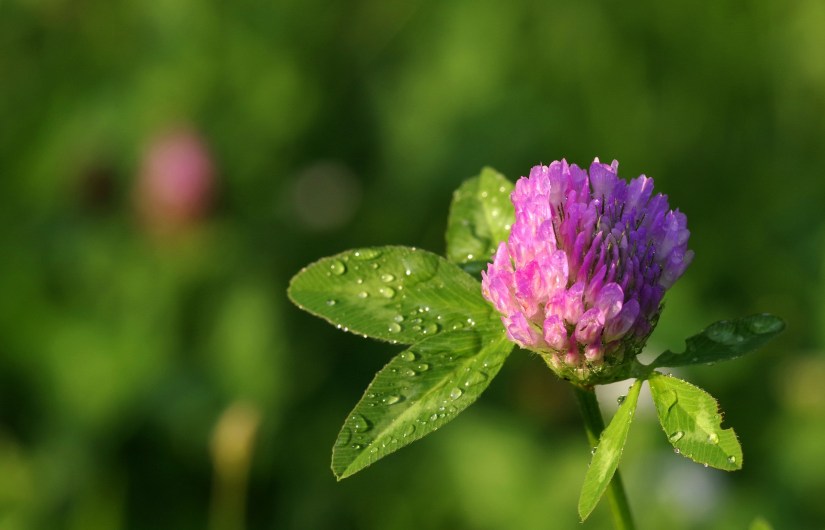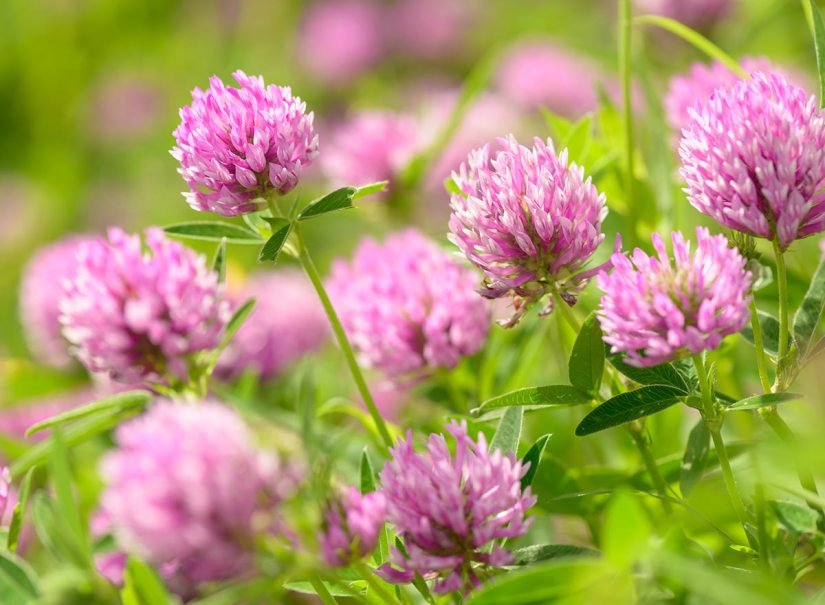Red Clover or scientifically known as Trifolium pratense L. is a wild flowering plant that is a member of the legume family.
While farm animals love to graze on this plant, people believe it to be a beneficial remedy to treat various health conditions.
Also, people tend to dry the blossoms for therapeutic purposes.
Then, read this article to be more familiar with red clover and know other benefits of this variety.
Contents
Red Clover Plant Identification and Characteristics

Indeed, one of the most essential identifying characteristics of Trifolium pratense is the watermark on its leaflets.
This creeping annual comes with trefoil foliages and tiny, pea-like blossoms in rose to magenta colors.
Its stunning flowers typically form oval clusters that make the plant somehow beautiful for completing your garden.
You may expect to see the red clover flower between May and September.
The plant itself has some local names including Suckbottles, Bee-bread, and Honeystalks. These mostly refer to the honey or sweet nectar that is available in its flowers.
Growth Habitat and Adaptation of Trifolium Pratense

Roadsides, grassy areas, and waste ground are among the common habitats of this plant. It has upright growth habitat and a short taproot.
Its stems are typically hairy and hollow. The main stem of this plant does not draw out, but it generates a lot of axillary branches at lower nodes.
Meanwhile, Trifolium pratense is a short-lived perennial. It can adapt to a huge variety of areas. However, this plant will grow best on well-drained soils.
You can expect a red clover child to deal with cold temperatures. It typically tolerates shade better compared to other legumes.
This plant is also capable to stand low fertility. Besides tends to endure moderately acid.
Thanks to its charming flower, gardeners love to grow this plant in mixtures with cool-season grasses.
How to Grow a Red Clover Seed Properly

The seeds of this plant are usually pure yellow to purple and their size is similar to the alfalfa seed.
You better prepare a quality seedbed at least six months before the projected planting date. This way the soil will have adequate time to adjust if any amendments are required.
If growing for hay, sow seeds eight to 10 inches apart and thin to around 12 inches.
Similar to others, they will need warm conditions and plenty of water to germinate perfectly.
For this reason, you should never start planting the seeds in arid or extremely dry places. If sowing in fall, make sure to sow a month before the usual first frost.
When sowing, be aware not to sow seeds so deeply. Make sure the depth is around a quarter inch for the best result.
Remember if you sow seeds too deep, they may fail to break through the soil surface later. Then, fertilize them concurrently as well with an organic mix that is high in phosphorus.
Top Red Clover Benefits That You Must Understand

Many people recognize this wild flowering plant as a natural remedy for various conditions including asthma, menopause signs, arthritis, whooping cough, and even cancer.
Despite the lack of scientific evidence regarding its benefits, many people claim that they find it helpful to treat some health issues.
However, instead of focusing on the advantages, you should understand both the red clover benefits and side effects before using it for treating any conditions.
Let’s review the potential benefits first before finding out the side effects and downsides of this clover.
-
Skin and Hair Health

Promoting hair and skin health is one of the clover’s benefits. In a study with 109 postmenopausal participants, it is reported that there are major improvements in appearance and texture.
If you are wondering about the red clover benefits for men, there is another study that discovered a 13-percent increase in the hair growth cycle in men.
Moreover, there is also a 29-percent decrease in the cycle of hair loss when male participants apply this clover extract to their scalp for four months.
-
Menopausal Signs

Red clover benefits for menopause symptoms are among the most popular ones. Its high isoflavone content becomes the reason why it can help with the signs.
A study found that there is a 73 percent decrease in hot flashes within three months of consuming a supplement that contains a variety of herbs including this clover.
However, since the supplement uses a huge number of ingredients, you cannot conclude if the clover plays a role in lowering the symptoms.
Some studies discovered mild improvements in some menopausal signs like depression, anxiety, and vaginal dryness as well.
Meanwhile, according to other studies, there are no improvements in menopausal signs after consuming this clover.
In this view, you can simply note that there is no clear evidence related to this plant recently.
-
Cardiovascular Health

A study in 2015 indicated a decrease in bad cholesterol in 147 postmenopausal women who took 50 mg of this clover every day for a year.
Another review discovered that taking the clover for four to 12 months also portrayed a decrease in bad cholesterol and a major increase in a good one.
One study showed that menopausal women have more flexible and stronger arteries after taking red clover supplements. This condition is very helpful to prevent heart disease.
However, a review in 2020 found that supplements containing this perennial herb did not elevate good cholesterol or reduce the bad one.
Thus, you may need to dig more to conclude that this plant is indeed helpful to deal with this condition.
-
Cancer

Aside from red clover benefits for skin and the above, you should be aware that this plant is also popular as a traditional cancer remedy.
Preliminary observation on isoflavones that is available in this closer suggests that it may prevent cancer cells from developing.
Researchers hypothesize that this plant may help endometrial and prostate cancer. Nevertheless, doctors do not suggest people use it due to the need for further study.
-
Osteoporosis and Other Uses

If red clover benefits for hair are not enough for you, this plant may help to slow bone loss thanks to its isoflavones content.
Several studies even suggested that a proprietary extract of this plant can enhance bone mineral density that prevents osteoporosis accordingly.
In addition to its extract in various supplements, you can also find this plant used traditionally as ointments for treating eczema, psoriasis, and other rashes.
You may also find that some people talk about red clover benefits for fertility, but you should note that most of these claims require further research to be valid.
How to Use Red Clover for Its Benefits

There is a variety of preparations available to enjoy the benefit of Trifolium pratense, including liquid extract, tinctures, teas, capsules, and tablets.
When it comes to topical application, this plant is also available as an ointment.
However, whatever the form is, you should never do self-treatment with it for more than three to six months without the supervision of healthcare professionals.
For an adult, the dose to take the preparation is different from one to another. In general, you can take fluid extract three times a day with 1 ml each.
If you want to make it into a cup of red clover tea, use the dried one and dilute it in 8 oz. hot water. Drink the beverage two to three cups a day.
Powdered clover herb is also available in capsules. You can take 40 to 160 mg daily. For isoflavone extracts, consume it by following the directions on the product label.
Meanwhile, if you prefer the tincture one, use 60 to 100 drops of it three times each day. You can also enjoy it as a tea by adding the mix to hot water.
To use clover ointment for topical treatment, apply as required unless the problem develops. You should not apply it on an open wound without a physician’s supervision.
Downsides and Side Effects of Trifolium pratense L.

It is no secret that the Good and Drug Administration (FDA) generally recognizes this perennial safe for consumption. Moreover, many studies promote it to be well tolerated as well.
However, be aware of its potential drug interactions and side effects.
For instance, those with hormone-sensitive states, such as ovarian cancer, breast cancer, or endometriosis, need to consult their doctor before consuming this clover.
There is also no safety data related to the use of this clover among pregnant and breastfeeding women or children.
Some may believe red clover benefits for weight loss too, but as there is limited evidence on it, you should not count on this plant for the better.
Even though rare, possible side effects of taking this clover include prolonged menstruation, nausea, vaginal spotting, headache, and skin irritation.
Furthermore, physicians also consider this plant capable to interfere with psoriasis medication, hormone replacement therapy, oral contraceptives, tamoxifen, and methotrexate.
In conclusion, considering the wide range of possible drug interactions with red clover and partial data on its effectiveness to treat various conditions, make sure to always talk to your healthcare professional before taking any new supplement containing this plant.
